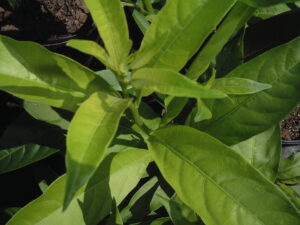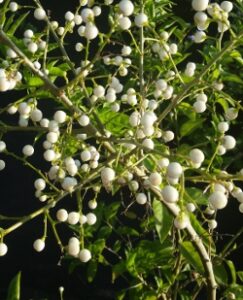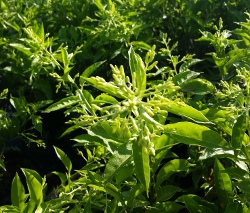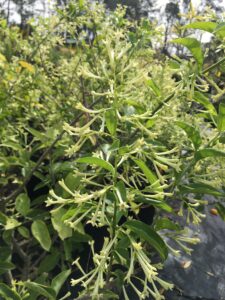S & J Nursery’s Guide to Growing
Night Blooming Jasmine
in the Northeast Florida Landscape
( Cestrum nocturnum )
Night Blooming Jasmine / Cestrum nocturnum Origins:
– Native to the West Indies portion of the Caribbean Basin,
night blooming jasmine plants are a tropical plant selection. Foliage is hardy in zones 10-11 and plants are
root hardy in zone 9B.
– Cultivated for their intense sweet fragrance that perfumes the entire
garden with just a single plant when in bloom. Although fragrance is present during the day time, it is just the slightest hint of what will happen at night. Flowers open in the evening and are intensely fragrant, so much so
that some may find it overpowering when planted to close to a homes entry. When I lived in a neighborhood I planted one out of sight on the side of my house but near enough to the front porch that I knew I would smell it
from my front porch swing. Neighbors out for a walk would stop by and ask what it was that smelled so good saying they had started to pick up its scent half a block away!
Sun Exposure for the Night Blooming Jasmine / Cestrum nocturnum:
– Night blooming jasmine plants are best planted in areas that will
receive full or partial sun. In Northeast Florida, a plant receiving 6 hours or more of sun exposure is considered to be planted in a full sun location. Morning shade and afternoon sun is ideal, or filtered light under taller growing shade trees. Plants will bloom less in lower light areas but may be better protected from damaging winter frosts in those same shadier locations.
– Best if planted on the south side of the house away from cold north winds,
up next to a fence or near the foundation of a home or other building, or near larger shade trees that will protect these tropical plants from frost. Or plant on the west side of a home or building.
 Foliage of the Night Blooming Jasmine / Cestrum nocturnum:
Foliage of the Night Blooming Jasmine / Cestrum nocturnum:
– A very unpretentious looking plant for having such a stunning smell, they blend right in among other foundation shrubs with light to medium green large leaves that can be from 4-8 inches long. Well, they blend in until they begin to bloom!
– Foliage will go down to the ground during the winter in our Northeast
Florida area gardens. But will quickly regrow from its roots the following spring in the Jacksonville and St. Augustine area gardens. As with all tropical plantings, they are particularly responsive to their individual planting location. When planted on the south side of the house away from north winds, or where receiving some frost protection from larger trees or nearby buildings.
– Leaves, flowers and berries all contain toxins, so plant at the
back of the border to keep nibbling creatures away.
Soil Preference / Salt tolerance of the Night Blooming Jasmine / Cestrum
nocturnum:
– Night blooming jasmine plants are at home in our Northeast
Florida’s sandy soils but will still benefit from soil amendment at planting time. Amend the soil when planting with compost to help your Jacksonville and St. Augustine area soil hold both water and nutrients and keep your cestrum plants healthy and blooming.
– Cestrum nocturnum is considered moderately salt tolerant, able to withstand coastal landscape conditions but not direct salt spray on the ocean side here in the Jacksonville and St. Augustine area landscape.
click here to open a new window for more information on salt tolerance of
Cestrum nocturnum / Night blooming jasmine
Size Variance of Cestrum Nocturnum / Night  Blooming Jasmine Plants:
Blooming Jasmine Plants:
– The foliage on the Night Blooming Jasmine plant can reach heights of 12
ft in more tropical areas of Florida. Here in our Northeast Florida landscape they are normally seen at around 3-4 ft high and wide, due to the winter regrowth.
Growth Habit of the Cestrum Nocturnum / Night Blooming Jasmine Plants:
– Upright foliage will produce long sprawling stems if not trimmed.
– Responds well to harsh pruning, so don’t be afraid to cut them
back and keep them nice and tidy!
Growth Rate of the Night Blooming Jasmine Plant:
– Here in the Jacksonville and St. Augustine area landscape, it may seem like your night blooming jasmine is sitting there doing nothing after trimming it in early springtime, but don’t get discouraged, as soon as summer rolls around these plants will quickly get to chest height and taller!
Blooms of the Night Blooming Jasmine / Cestrum nocturnum:
– Blooms on an off a few times each year during summer and fall.
– One inch long tubular blooms in large cascading
clusters, blooms are highly aromatic at night time. One plant is enough to perfume your entire yard on most landscape sites!
– Creamy white non edible berries follow the white bloom clusters.
Water Requirements of the Night Blooming Jasmine Cestrum Nocturnum:
– Although much more durable once established in the landscape, regular water is necessary to get the plant rooted and growing on its own after being planted in the ground from an S & J Nursery container. Water every day for the first week then every other day for the next week, and continue to taper watering black to a minimum of once a week or every time the top 2 inches of the soil is dry to the touch. Fully rooted and established cestrum plants are moderately drought tolerant and should only need supplemental irrigation in times of drought.
 Best Uses For Night Blooming Jasmine in the Jacksonville | St. Augustine Area Landscapes :
Best Uses For Night Blooming Jasmine in the Jacksonville | St. Augustine Area Landscapes :
– Cestrum plants can be used in foundation plantings, as an accent near
entry ways patio areas porches or windows where the fragrance can easily be enjoyed, espalier, or potted plant.
– Use in butterfly gardens as larval plant for butterfly caterpillars.
– Easy care landscape plant , with the minimum of a once a year trimming
needed.
– makes an excellent hedge screen when planted along side of wooden
fences, etc.
Care of Night Blooming Jasmine in the Northeast Florida Landscape:
– Amend sandy soils generously with compost to help your night blooming
jasmine plants get the much needed water and nutrients it takes to feed these ever blooming beauties.
– Water every day during the establishment period after planting in the garden from an S & J Nursery container. Be sure to continue supplemental irrigation during the hot summer months during prolonged grouts.
– Fertilize each year just after trimming in the spring with a good shovel full of garden compost or use Osmocote or another slow release plant food spring, summer and fall.
– When temperatures drop below 30 degrees you may opt to protect your foliage and stems from severe frost damage by throwing a blanket or other breathable fabric over the top of the plant making sure the edges touch the ground to trap in the heat from the soil.
– Make your last summer pruning in August giving your night blooming
jasmine plant ample time to recover new foliage that will harden off before winter arrives for us here in late December. Pruning to late into the fall will cause flushes of cold sensitive new growth that is sure to freeze during even a light frost that hardened off foliage would not be affected by.
– DO NOT REMOVE BURNT FOLIAGE UNTIL ALL DANGER OF FROST HAS PASSED. Be sure not to remove any stems or leaves from the plant until we have reached the last average frost date and there are no late freezes being predicted. ( mid February for Northeast Florida is the average last frost date) Trimming burnt foliage and stems before then will leave bare branches deeper on the plant exposed to cold temperatures that would have been protected by those same stems and foliage if left unpruned and most often results in loss of the plant entirely.


